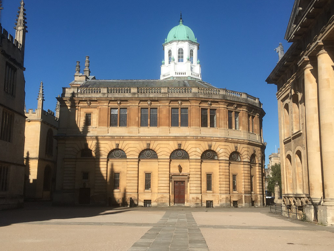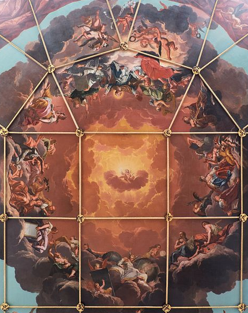The Sheldonian Theatre
One of the most classically-inspired buildings in Oxford is Sir Christopher Wren’s Sheldonian Theatre. It was built as a ceremonial and assembly hall for the University of Oxford. Previously, the University Church had been used for large University gatherings and ceremonies. Archbishop Sheldon, former student of Trinity College and Chancellor of the University from 1667 to 1669, decided that the University had outgrown the church and pledged some of his own money for a new building. He ended up paying for the entire project, around 12x what he had anticipated. On this basis, it seemed reasonable for it to be named after him.
Sheldon approached Christopher Wren, who was the Savilian Professor of Astronomy and was just at the beginning of his architectural career. Wren’s only big project to date had been the chapel of Pembroke College, Cambridge. So, he looked around for inspiration and found the Theatre of Marcellus in Rome. As you can see, he didn’t copy it exactly. His main addition, of course, was a roof. Given the notoriously unpredictable and frequently rainy British weather, he decided that building it without one was not an option.
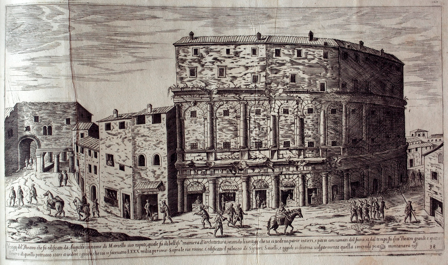
This (below) was how the Sheldonian originally looked. As you can see, the roof was surrounded by oval windows. This was partly because it was to house the Oxford University Press, but the windows proved impractical and leaky and were removed in the 19th century. The cupola was also later re-designed by Edward Blore. However, the original roof was an impressive structure, all the more so because it spanned 70 foot without using any columns at all.
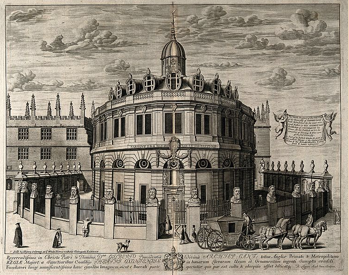
Photo: Wikimedia commons. From Wellcome Images, Fae 2014
This (below) is what the Sheldonian Theatre looks like today. It serves for large University gatherings: matriculation and graduation ceremonies and meetings of Congregation, the sovereign body of the University consisting of about 5,500 members – unfortunately, they can’t all come at once, since the Sheldonian today has a capacity of 750 people. This also means that the University of Oxford doesn’t just have one ‘Graduation Day’ but has around 20 per year.
Photo © Victoria Bentata 2020
Inside, the theatre is as impressive as it is outside, in particular because of its extraordinary ceiling. This consists of 32 panels, painted by Robert Streater, who was the court painter to Charles II. Take a look at it. It may not be immediately obvious, but you are looking at a cloud on the background of a blue sky with a red cloth rolled back around it. Criss-crossing the ceiling are golden ropes. In Roman theatres, the lack of a roof was compensated by such a cloth, which was pulled across the open roof in inclement weather. Christopher Wren was clearly at pains to pretend that there wasn’t really a roof to his building. However, the advantage of the painted ceiling was that the sky could be populated with all the representatives of the arts and sciences seated around a cherub representing truth. The ceiling was teaching a lesson about the supremacy of truth over the University disciplines and, unfortunately not visible here, it also shows ignorance being expelled. Ignorance is a man with snake for hair, who appears below the bottom of this picture. If you want to see him, come to Oxford and let us show you the Sheldonian Theatre. The ceiling was also apparently an allegory celebrating the Restoration of the British Monarchy under Charles II after the years under Oliver Cromwell’s Puritans.
Photo Wikimedia commons by DeFacto
Have a look at the following picture to see the interior of the Sheldonian during a Matriculation Ceremony. Matriculation is when new students are officially added to the ‘Matricula’ or University membership roll and become full members of the University. The students have to wear the University of Oxford’s uniform, the ‘Sub Fusc’ – white shirt, black trousers/skirt, black gown and mortar board hat. You can see them all here.
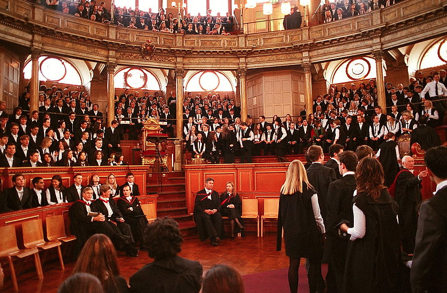
Photo: Wikimedia Commons Toby Ord 2003
Here you can see a photo from a Graduation Ceremony. The Pro-Vice Chancellor presiding is wearing an MA gown, whilst the graduate bowing to her is just being awarded his DPhil, which is the Oxford equivalent of a PhD.
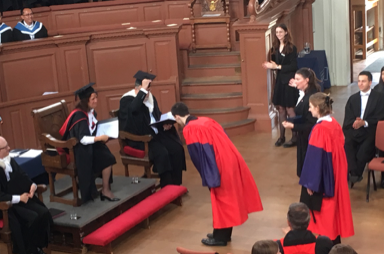
Photo: © Victoria Bentata
At Walking Tours of Oxford, we would be delighted to take you to the Sheldonian Theatre and point out some of the fascinating features of the building. You can even climb up to the Cupola for a fabulous view of central Oxford.
© Victoria Bentata 2020 for Walking Tours of Oxford

